When I lived and taught in New Orleans, LA, I was the proud owner of a colorful t-shirt emblazoned with images of 40 front covers of books that have been challenged or banned over the years. I was even prouder to have read and owned all those books. I firmly maintain there is value in reading and discussing books that expand one’s worldview and sometimes make a reader feel uncomfortable. Although I might not relish every single book on that banned book t-shirt or even those on the current list of frequently challenged books maintained by the American Library Association (ALA), I support the right of authors and illustrators to share their words and visions and for individuals to read their books. Discourse about conflicting ideas is one of the founding principles of a democracy. Intellectual freedom should be cherished.
Banned Books Week, a partnership of book publishers, sellers, and advocates of intellectual freedom—including teachers and librarians—provides an annual reminder of the importance of being able to have choice in what one reads. This year, the event runs September 25–October 1, under the banner of Stand Up for Your Right to Read. Chances are that a bookstore or library near you will have displays and speakers lauding the freedom to read. If not, you might consider taking the lead on this project. There are excellent resources provided on ALA’s website.
Clearly, Banned Books Week brings together book lovers in support of intellectual freedom. Just as clearly, those of us who cherish the right to read should make sure we celebrate this right on a daily basis.
ALA’s Office of Intellectual Freedom collects and compiles reports from libraries, schools, and the media on attempts to ban books. Often, the same books are challenged year after year. Below are the 10 most challenged books of 2015.
- Looking for Alaska, by John Green,cited for offensive language, being sexually explicit, and being unsuitable for age group.
- Fifty Shades of Grey, by E.L. James, challenged for being sexually explicit, unsuited for age group, poorly written, and concerns that teens will try some of the practices described in the book.
- I Am Jazz, by Jessica Herthel and Jazz Jennings, challenged for being inaccurate and for dealing with homosexuality and sex education, for its religious viewpoint, and for being unsuited for age group.
- Beyond Magenta: Transgender Teens Speak Out, by Susan Kuklin, challenged for being anti-family, offensive language, references to homosexuality and sex education, and because of its political and religious viewpoints, and for being unsuited for age group.
- The Curious Incident of the Dog in the Night-Time, by Mark Haddon, challenged for offensive language and its religious viewpoint, for being unsuitable for age group, and for profanity and atheism.
- The Holy Bible, challenged because of its religious viewpoint.
- Fun Home, by Alison Bechdel, challenged for its violence and graphic images.
- Habibi, by Craig Thompson, challenged for nudity, for being sexually explicit and unsuited for age group.
- Nasreen’s Secret School: A True Story From Afghanistan, by Jeanette Winter, challenged because of its religious viewpoint, for being unsuited to age group, and for violence.
- Two Boys Kissing, by David Levithan, challenged because of homosexuality and for condoning public displays of affection.
Some of these books were published for adult readers. Below I review five titles on the list, books written for children and young adults, all books that I consider essential reading. All of them tell important stories. I would never support removing these books or the others on the list from library shelves.
Ages 4–8
I Am Jazz. Jessica Herthel & Jazz Jennings. Ill. Shelagh McNicholas. 2014. Dial/Penguin.
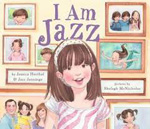 The picture book story of Jazz Jennings’s experiences as a transgender girl is simplified here, offering a conversational starting place for parents and teachers to discuss gender roles and gender identity with young children. Through Jazz’s own words, readers are provided with a glimpse into Jazz’s world and her parents’ struggles and eventual coming to terms with their child’s identification as a girl. Jazz herself says that she knew she was a girl at the age of 2. Although it gently addresses the challenges she and her family have faced over bathroom issues and sports team, the book tells Jazz’s story in a positive fashion, offering encouragement and hope for others who are figuring out their own identity. Jazz’s honest story could lead to acceptance, understanding, and appreciation for those like her who have struggled to be allowed to be the person they know they were born to be. Although the book depicts how frustrating and confusing Jazz’s early days were, it also demonstrates the many ways she is just like any other youngster. Rendered with watercolor paints, the colorful illustrations bring a bright and cheerful focus to Jazz’s story that matches her own attitude. This important, groundbreaking book contains three photographs of Jazz as well as her image on the book jacket.
The picture book story of Jazz Jennings’s experiences as a transgender girl is simplified here, offering a conversational starting place for parents and teachers to discuss gender roles and gender identity with young children. Through Jazz’s own words, readers are provided with a glimpse into Jazz’s world and her parents’ struggles and eventual coming to terms with their child’s identification as a girl. Jazz herself says that she knew she was a girl at the age of 2. Although it gently addresses the challenges she and her family have faced over bathroom issues and sports team, the book tells Jazz’s story in a positive fashion, offering encouragement and hope for others who are figuring out their own identity. Jazz’s honest story could lead to acceptance, understanding, and appreciation for those like her who have struggled to be allowed to be the person they know they were born to be. Although the book depicts how frustrating and confusing Jazz’s early days were, it also demonstrates the many ways she is just like any other youngster. Rendered with watercolor paints, the colorful illustrations bring a bright and cheerful focus to Jazz’s story that matches her own attitude. This important, groundbreaking book contains three photographs of Jazz as well as her image on the book jacket.
Nasreen’s Secret School: A True Story From Afghanistan. Jeanette Winter. 2009. Beach Lane/Simon & Schuster.
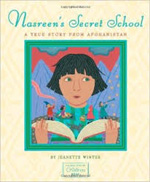 As the violence and confusion of war in Afghanistan paint her homeland with despair and dismal images, Nasreen has lost almost all there is to lose, including her parents, and yet her grandmother offers her hope even while turmoil swirls through her city’s streets. Under her grandmother’s firm guidance and conscious act of revolution, Nasreen attends school secretly. Simply becoming educated, a process that students in many countries take for granted, becomes an act of rebellion and an indicator of the brighter future that may lie ahead for Nasreen and others like her. The color-drenched illustrations highlight moments of tranquility snatched while violence rages around this young girl. Reading this book might remind young readers of the power of literacy and how reading truly can open up entire worlds and change lives.
As the violence and confusion of war in Afghanistan paint her homeland with despair and dismal images, Nasreen has lost almost all there is to lose, including her parents, and yet her grandmother offers her hope even while turmoil swirls through her city’s streets. Under her grandmother’s firm guidance and conscious act of revolution, Nasreen attends school secretly. Simply becoming educated, a process that students in many countries take for granted, becomes an act of rebellion and an indicator of the brighter future that may lie ahead for Nasreen and others like her. The color-drenched illustrations highlight moments of tranquility snatched while violence rages around this young girl. Reading this book might remind young readers of the power of literacy and how reading truly can open up entire worlds and change lives.
Ages 12–14
Beyond Magenta: Transgender Teens Speak Out. Susan Kuklin. 2014. Candlewick.
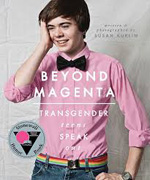 In this unique collection of interviews intended to subvert gender stereotypes, six teens share their experiences as members of the transgender community. Although there are similarities and overlap in some of the stories and experiences, the journeys described here are unique and certain to evoke compassion and understanding. Readers may flinch at the struggles and applaud the hard-won victories of Jessy, Christina, Mariah, Cameron, Nat, and Luke. Containing some before and after photographs as they transitioned into the gender they were meant to be, the book includes comments from the parents (and significant others) of several of the teens. As much as many of us think we know about this topic, these teens have much to teach us, including the importance of using gender-neutral terms when referring to others and not making assumptions about someone’s gender. The back matter includes helpful resources and a glossary of terms. These shared stories have broken boundaries, opened minds, and allowed others to be themselves. Readers may find it comforting to consider the idea expressed in the book that all of us are somewhere along a spectrum when it comes to gender identity, neither completely male nor completely female.
In this unique collection of interviews intended to subvert gender stereotypes, six teens share their experiences as members of the transgender community. Although there are similarities and overlap in some of the stories and experiences, the journeys described here are unique and certain to evoke compassion and understanding. Readers may flinch at the struggles and applaud the hard-won victories of Jessy, Christina, Mariah, Cameron, Nat, and Luke. Containing some before and after photographs as they transitioned into the gender they were meant to be, the book includes comments from the parents (and significant others) of several of the teens. As much as many of us think we know about this topic, these teens have much to teach us, including the importance of using gender-neutral terms when referring to others and not making assumptions about someone’s gender. The back matter includes helpful resources and a glossary of terms. These shared stories have broken boundaries, opened minds, and allowed others to be themselves. Readers may find it comforting to consider the idea expressed in the book that all of us are somewhere along a spectrum when it comes to gender identity, neither completely male nor completely female.
Ages 15+
Looking for Alaska. John Green. 2005. Dutton/Penguin.
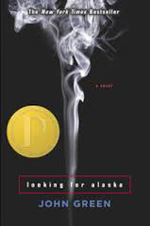 Sixteen-year-old Miles Halter finds more challenges than he expected when he attends an Alabama boarding school and leaves his Florida home behind. Quirky misfit Miles enjoys collecting the last words of famous dead people, and he worries that he won’t fit in at his new school. After all, he lacks life experiences. But fortunately for Miles, he falls in with a group of would-be intellectuals more interested in smoking, drinking, hooking up, and having fun than what they’re supposed to be learning in their classrooms, and he starts catching up on all that he has been missing. Miles is attracted to Alaska Young, the girlfriend of his roommate, and yearns for this self-destructive young woman even while conducting a courtship with another classmate. The chapter headings and vignettes hint of the tragedy to come even while exploring the impact of love, loss, and grief. While looking for Alaska and others like her, Miles attempts to find himself. Teen readers are sure to identify with one of the characters in this winner of the 2006 Michael L. Printz Award.
Sixteen-year-old Miles Halter finds more challenges than he expected when he attends an Alabama boarding school and leaves his Florida home behind. Quirky misfit Miles enjoys collecting the last words of famous dead people, and he worries that he won’t fit in at his new school. After all, he lacks life experiences. But fortunately for Miles, he falls in with a group of would-be intellectuals more interested in smoking, drinking, hooking up, and having fun than what they’re supposed to be learning in their classrooms, and he starts catching up on all that he has been missing. Miles is attracted to Alaska Young, the girlfriend of his roommate, and yearns for this self-destructive young woman even while conducting a courtship with another classmate. The chapter headings and vignettes hint of the tragedy to come even while exploring the impact of love, loss, and grief. While looking for Alaska and others like her, Miles attempts to find himself. Teen readers are sure to identify with one of the characters in this winner of the 2006 Michael L. Printz Award.
Two Boys Kissing. David Levithan. 2013. Alfred A. Knopf/Random House.
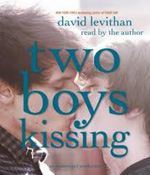 Former boyfriends Craig and Harry may no longer be together, but the two 17-year-olds like each other enough to try to set a new record for longest continuous kiss for the Guinness Book of World Records. Kissing for 32 hours provides a chance for reflection, affording them with time to examine their feelings for one another and deal with the consequences of their actions. While Harry’s parents support their son and have no problem with the media attention garnered by the boys’ locked lips, Craig’s mother has no idea that her son is gay. The book also explores the experiences of other teens and includes posthumous narratives by several men who died from AIDS, thus offering readers and the characters themselves a glimpse into the past, present, and future of gay rights and gender identification. Kudos to the publisher for appropriately placing an image of two adolescent males kissing on the cover.
Former boyfriends Craig and Harry may no longer be together, but the two 17-year-olds like each other enough to try to set a new record for longest continuous kiss for the Guinness Book of World Records. Kissing for 32 hours provides a chance for reflection, affording them with time to examine their feelings for one another and deal with the consequences of their actions. While Harry’s parents support their son and have no problem with the media attention garnered by the boys’ locked lips, Craig’s mother has no idea that her son is gay. The book also explores the experiences of other teens and includes posthumous narratives by several men who died from AIDS, thus offering readers and the characters themselves a glimpse into the past, present, and future of gay rights and gender identification. Kudos to the publisher for appropriately placing an image of two adolescent males kissing on the cover.
Barbara A. Ward teaches graduate and undergraduate courses in literacy at Washington State University, Pullman. She spent 25 years teaching in the public schools of New Orleans, where she worked with students at every grade level, from kindergarten through high school as well as several ability levels. She is certified in elementary education, English education, and gifted education. She holds a bachelor's in Communications, a master's in English Education from the University of Tennessee and a PhD in Curriculum and Instruction from the University of New Orleans.
These reviews are submitted by members of the International Literacy Association's Children's Literature and Reading Special Interest Group (CL/R SIG) and are published weekly on Literacy Daily.